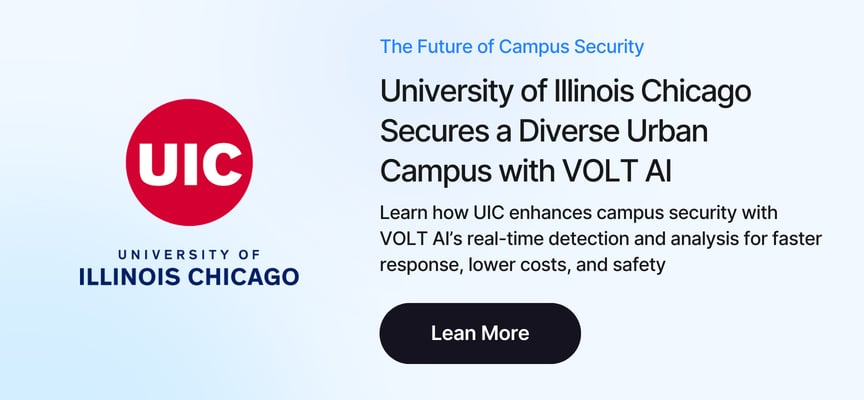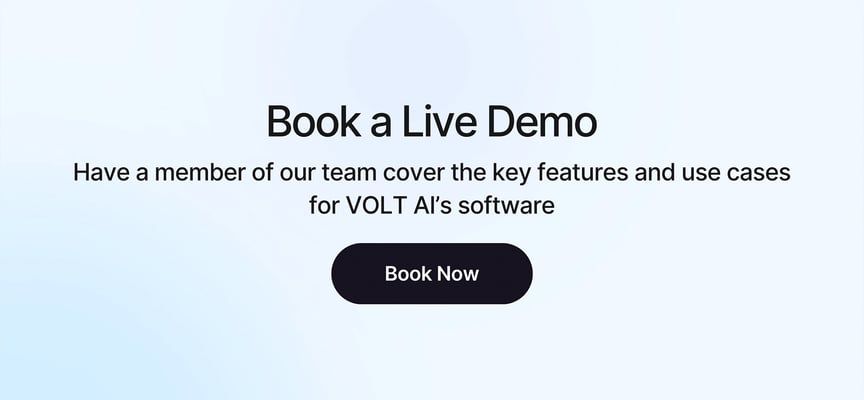Key Points
- Instant threat detection: AI-powered security cameras identify weapons, medical emergencies, and security incidents within seconds of occurrence
- Real-time tracking capabilities: Advanced algorithms track individuals across multiple camera feeds without relying on facial recognition technology
- Proactive response protocols: Systems alert security teams immediately while incidents are developing, not after they've escalated
- Comprehensive coverage: Single platform monitors 100% of camera feeds continuously, eliminating blind spots in campus safety and security
- Privacy-preserving technology: Detection relies on behavioral patterns and clothing descriptions rather than biometric identification
The Evolution Beyond Traditional Campus Security
Campus safety and security teams face unprecedented challenges in protecting sprawling university environments. Traditional security cameras provide valuable footage for post-incident investigations. They fall short of preventing threats in real-time.
Modern AI-powered security systems represent a fundamental shift from reactive to proactive campus protection. These intelligent platforms analyze video feeds continuously, identifying potential threats before they escalate into serious incidents.
Current Limitations in Campus Security Systems
Most universities face significant gaps in their campus safety and security coverage that AI technology can address:
- Limited monitoring capacity: Security teams typically monitor less than 5% of camera feeds in real-time due to staffing constraints
- Human operator fatigue: Personnel watching multiple screens experience decreased attention after 12 minutes, with 95% of activities missed after 22 minutes
- Reactive response model: Traditional systems rely on post-incident investigation rather than prevention
- Coverage blind spots: Large campus areas remain unmonitored during critical hours
- Resource allocation challenges: Third-party security contractors often provide inconsistent coverage and reliability
Learn from real campus security leaders implementing AI solutions.
Understanding AI-Powered Campus Security Technology
AI security cameras leverage sophisticated computer vision algorithms and machine learning models to analyze video streams in real-time. The technology processes visual data through advanced neural networks, including visual transformers and convolutional neural networks. These systems are trained on extensive datasets of security incidents and normal campus activities.
The detection process operates through multiple layers of analysis. Initial algorithms identify objects, people, and activities within camera frames.
Core Detection Capabilities for Higher Education
Modern AI security systems excel at identifying multiple types of campus security threats simultaneously:
- Weapon detection: Identifies firearms, knives, and dangerous objects even when partially concealed
- Medical emergency response: Recognizes when individuals have fallen, collapsed, or show signs of distress
- Behavioral analysis: Detects fighting, aggressive behavior, and crowd formations indicating potential conflicts
- Unauthorized access monitoring: Tracks individuals in restricted areas during specified times
- Suspicious activity identification: Recognizes loitering, unusual movement patterns, and other concerning behaviors
Detection Type | Response Time | Coverage Area | Key Security Features |
Weapon Detection | 2-15 seconds | 360-degree camera view | Works in various lighting conditions |
Medical Emergency | 5-20 seconds | Full camera coverage | Distinguishes falls from normal activities |
Fighting/Aggression | 10-30 seconds | Multi-camera tracking | Recognizes escalating situations |
Unauthorized Access | Immediate | Zone-based rules | Customizable time and location parameters |
Real-Time Tracking and Continuous Campus Monitoring
Advanced AI security cameras maintain tracking across multiple camera feeds throughout a facility. Unlike traditional systems that lose subjects when they move between camera views, AI creates continuous visual contact.
The tracking technology uses sophisticated algorithms that identify individuals based on clothing, gait, and movement patterns. This approach addresses privacy concerns while maintaining effective campus public safety balancing privacy and security monitoring.
Advanced Tracking Features for Educational Institutions
AI security systems provide comprehensive monitoring capabilities that enhance campus safety:
- Cross-camera tracking: Maintains visual contact as individuals move between different camera zones
- Privacy-preserving identification: Uses behavioral patterns rather than facial recognition technology
- Threat persistence monitoring: Continues tracking even after weapons are concealed or put away
- Movement pattern analysis: Identifies unusual routes or behaviors that may indicate security concerns
- Zone-based rule enforcement: Applies different monitoring criteria based on location and time
3D Facility Mapping Integration
Advanced AI security platforms incorporate detailed 3D mapping of campus facilities to enhance tracking accuracy. These digital twins of physical spaces provide security teams with intuitive visual representations of incidents.
The mapping technology divides campus areas into security zones with customizable monitoring rules. Public areas might have different alert parameters than restricted zones or sensitive facilities.
Security Zone Type | Monitoring Level | Alert Triggers | Response Protocol |
Public Areas | Standard | Weapons, medical emergencies | Security team notification |
Restricted Zones | Enhanced | Any unauthorized access | Immediate security dispatch |
Sensitive Facilities | Maximum | All suspicious activity | Law enforcement alert |
Dormitory Areas | Customized | After-hours violations | Residential life notification |
Case Study: University of Illinois Chicago Implementation
The University of Illinois Chicago (UIC) provides an excellent example of AI security transformation in higher education. With over 30,000 students across a 250-acre urban campus, UIC faced significant security challenges.
UIC implemented AI-powered video surveillance across 142 critical camera streams. The system addressed multiple security concerns simultaneously, from weapon detection to parking lot monitoring.
Implementation Results and Benefits
UIC's AI security deployment delivered measurable improvements across multiple areas:
- Operational cost reduction: Decreased third-party security contractor reliance by approximately 50%
- Enhanced detection capabilities: Successfully identified concealed weapons in crowded environments
- Improved maintenance efficiency: Camera health monitoring alerts IT teams faster than traditional systems
- Parking operations optimization: Automated incident detection prevents costly equipment damage
- Stakeholder satisfaction: Multiple departments requested expanded coverage after pilot success
The implementation yielded immediate results during the pilot phase. The system successfully detected both real threats and training scenarios.
Technical Integration Success
UIC's implementation demonstrated several key technical advantages for campus safety and security:
- Seamless infrastructure integration: Worked with existing camera networks without hardware replacement
- Network security compliance: Output-only data flow eliminated security vulnerabilities
- Scalable deployment model: Pilot success led to university-wide expansion planning
- Multi-stakeholder value: Parking, athletics, and security departments all benefited from the system
Case Study: Maryville University's Proactive Security Approach
Maryville University represents a different implementation model, focusing on comprehensive security planning. With approximately 1,000 on-campus residents and 600+ camera installations, the university sought proactive campus security solutions.
The university's security team evaluated multiple AI security providers before selecting a platform. The real-time tracking capabilities proved decisive in the selection process.
Comprehensive Security Benefits
Maryville's implementation demonstrates multi-departmental value creation:
- Athletics security: After-hours monitoring identifies unauthorized facility access
- Residential life support: Tools for addressing dormitory security concerns and policy violations
- Community engagement: Proactive officer response to detected incidents improves campus climate
- Administrative insights: Detailed reporting supports evidence-based security planning
- Liability reduction: Proactive threat detection significantly reduces institutional risk exposure
Rapid Deployment Success
Implementation occurred with minimal campus disruption:
- Hardware simplicity: Single device connection to existing school camera systems infrastructure
- Backup redundancy: Secondary systems provided for continuous operation assurance
- Quick activation: Full operation achieved within days of installation
- Staff adaptation: Security teams quickly integrated AI alerts into existing protocols
Implementation Protocols and Best Practices
Successful AI security implementation requires systematic planning and stakeholder coordination. Universities should begin with comprehensive needs assessment that identifies specific security challenges.
Camera selection represents a critical implementation decision. Organizations with limited campus security teams may choose pilot programs focusing on high-priority areas.
Essential Implementation Steps for Campus Safety
Follow these key phases for successful AI security deployment:
- Needs assessment phase: Evaluate current security gaps, infrastructure capabilities, and stakeholder requirements
- Pilot program design: Select high-priority areas for initial deployment and testing
- Staff training development: Create comprehensive protocols for AI alert response and system operation
- Integration planning: Ensure compatibility with existing emergency management and communication systems
- Performance monitoring: Establish metrics for measuring system effectiveness and ROI
Technical Integration Considerations
AI security systems must integrate seamlessly with existing campus infrastructure:
- Network capacity evaluation: Assess bandwidth requirements for video processing and data transmission
- Server and storage planning: Determine cloud versus on-premises deployment based on institutional needs
- Privacy compliance: Implement systems that meet regulatory requirements while maintaining security effectiveness
- Customization requirements: Configure detection zones, alert parameters, and response protocols for campus-specific needs
Implementation Phase | Timeline | Key Activities | Success Metrics |
Planning & Assessment | 2-4 weeks | Needs analysis, stakeholder input | Requirements documentation complete |
Pilot Deployment | 1-2 weeks | Limited camera integration | System functionality verified |
Full Implementation | 2-6 weeks | Complete system deployment | Coverage targets achieved |
Training & Optimization | Ongoing | Staff education, system tuning | Response time improvements documented |
Response Protocols and Emergency Management
AI-powered security systems excel at enabling rapid response to campus security incidents. Alert protocols can be customized to notify appropriate personnel based on incident type, location, and severity.
The technology supports graduated response protocols that escalate notifications based on incident development. Initial alerts might go to security supervisors, with automatic escalation if incidents aren't acknowledged.
Emergency Response Integration
Modern AI security platforms coordinate with existing emergency management systems:
- Automated lockdown triggers: Weapon detection can immediately initiate campus lockdown procedures
- Emergency communication activation: Systems integrate with campus alert networks for immediate notifications
- Law enforcement coordination: Direct integration with 911 systems and local police dispatch
- Medical response protocols: Automatic notification of campus medical services for health emergencies
- Evacuation procedure initiation: AI systems can trigger building evacuations based on threat assessment
Read our Complete Guide to AI-Powered Campus Security Systems.
Continuous Improvement Through Data Analysis
AI security systems generate valuable data for ongoing campus safety program enhancement:
- Incident pattern analysis: Identify trends in security events across campus locations and timeframes
- Response time optimization: Track and improve emergency response efficiency through detailed metrics
- System performance monitoring: Analyze detection accuracy and false positive rates for continuous tuning
- Resource allocation insights: Use data to optimize security staffing and equipment deployment
- Evidence-based planning: Support budget justification and policy development with concrete performance data
The technology's evolution beyond weapon detection toward predictive capabilities represents the next frontier in campus security. Systems that can identify potential threats before they materialize offer the possibility of prevention rather than response. The future of campus security operations combines human expertise with AI capabilities, making it possible for institutions to provide comprehensive protection while maintaining the open, welcoming atmosphere essential to higher education.
This technological evolution also brings important considerations about campus security ROI and justifying AI investment versus traditional security approaches. Universities must carefully evaluate the long-term benefits and cost savings that AI-powered systems provide when compared to conventional security measures. The data clearly demonstrates that implementing advanced security technology creates measurable value that extends far beyond initial deployment costs.
Additionally, private schools and smaller colleges are finding that AI security solutions can provide enterprise-level protection regardless of campus size or budget constraints. These institutions benefit from the same advanced capabilities as larger universities, with systems that scale appropriately to their specific needs and resources.






